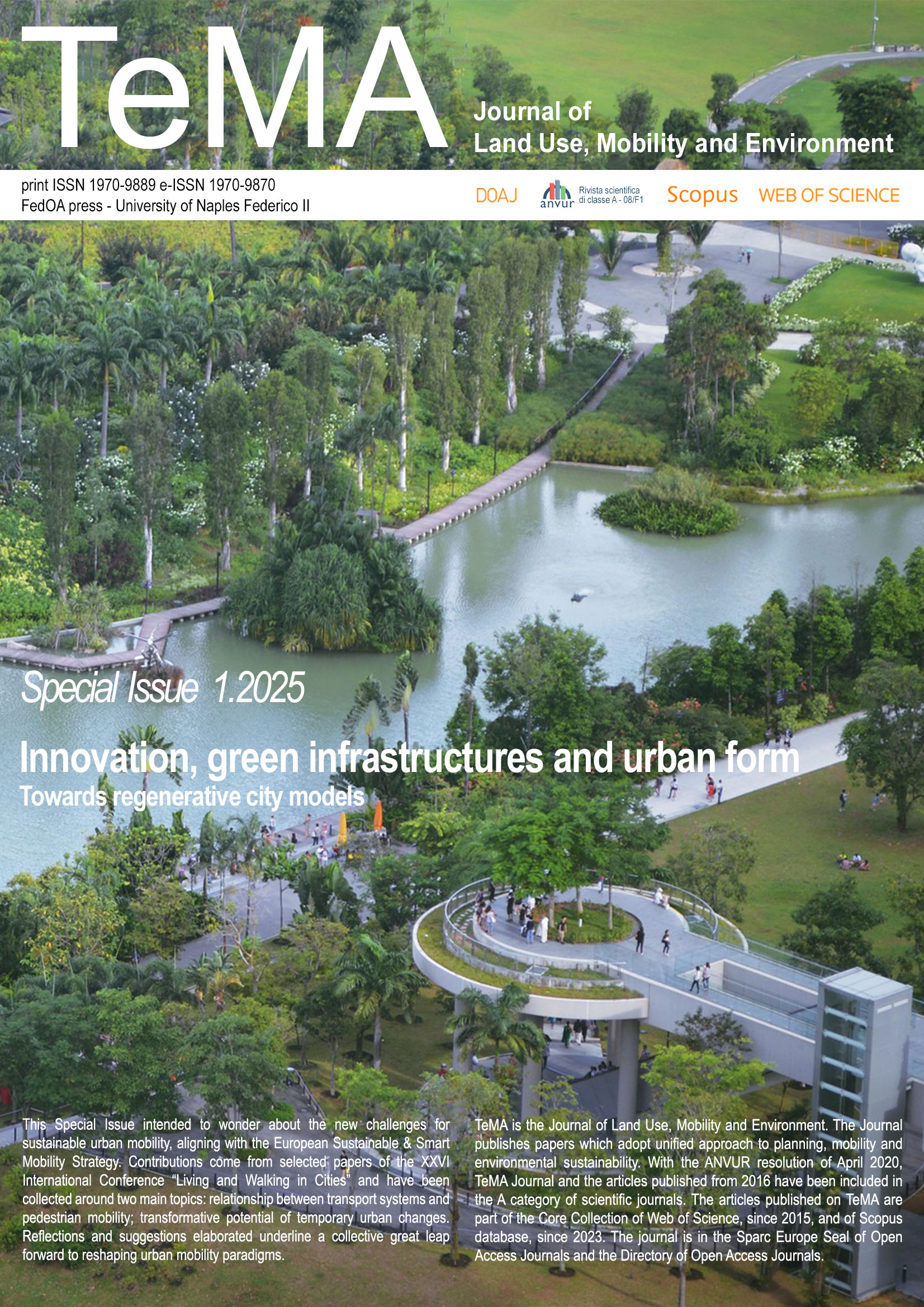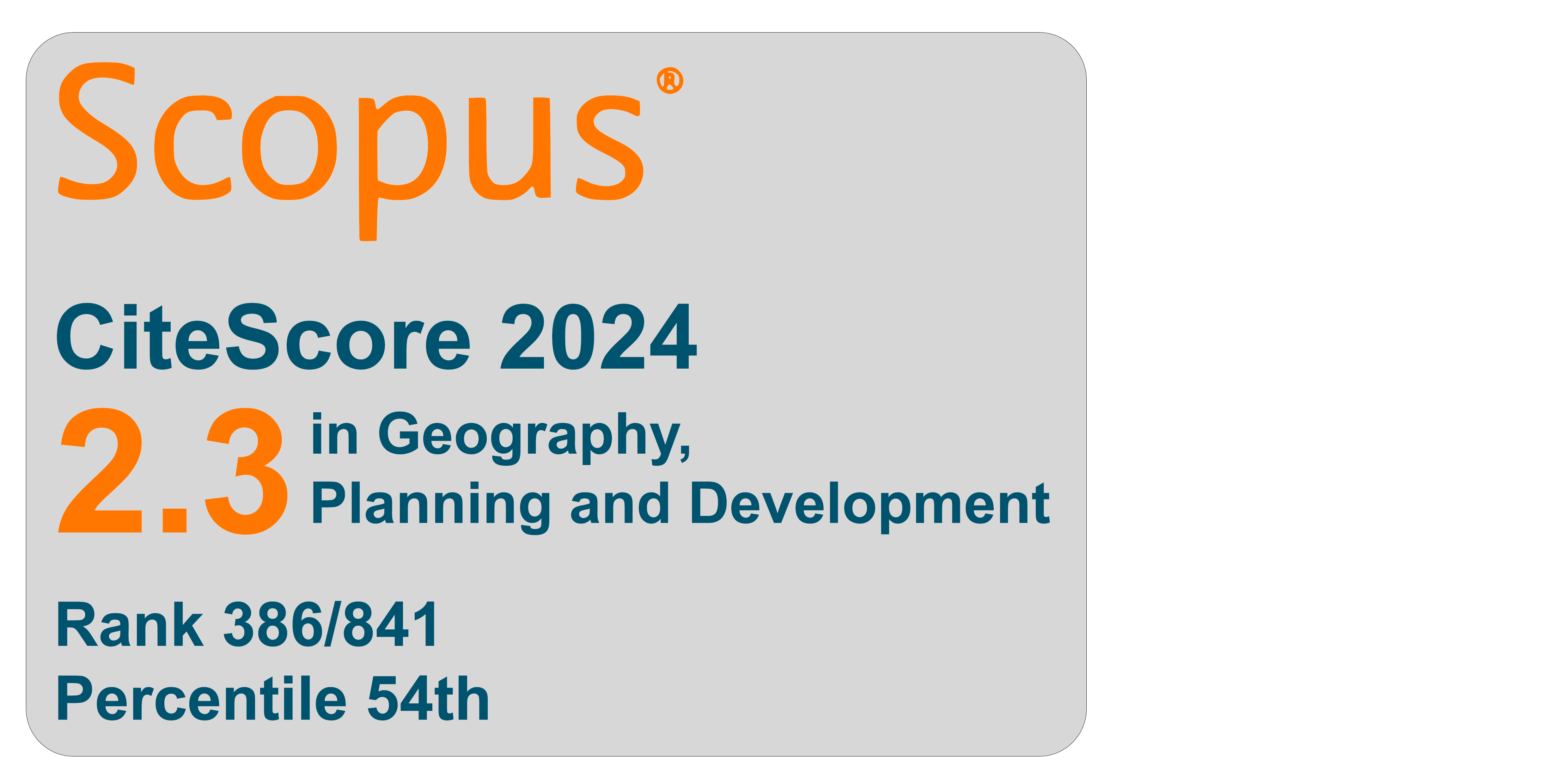Vulnerable Viterbo. Ancient city form and contemporary pressures
DOI:
https://doi.org/10.6093/1970-9870/11139Keywords:
Urban Form, Planning, Ciy of ViterboAbstract
In Italy the problem of climate change is a question of study that is unfortunately quite recent, more or less since 2015 we have started to understand that this problem exists but it often remains only in administrative theory. The context of the study is emblematic because it is defined by the city of Viterbo in which the system of urban planning rules belongs to a vision, to an idea of the city developed between the 1950s and 1960s and culminated in the approval of the PRG “Smargiassi-Salcini” of 1956 which then merged into the General Variation of 1979, the last unitary instrument of control of the city. Since the 1980s, the city has escaped any holistic vision, avoided the urban planning approach and governance, and pursued its own development outside the master plan rules, favoring the partial variants. The National Recovery and Resilience Programme, presented and hoped for by many as a policy to control territorial imbalances, has not succeeded in this undertaking and has actually contributed to widening the gap between what falls within the domains of the urban planning discipline and what is instead delegated to mere urban or even architectural design.
Downloads
References
AA.VV. (1993). Viterbo – Politica, economia, cultura e sport 1945-1992, DEUI Editore
Bentivoglio, E., Valtieri, S. (1982). Guida a Viterbo, Edizioni Dedalo
Ceci, M., Caselli, B. & Zazzi, M. (2023). Soil de-sealing for cities’ adaptation to climate change. TeMA - Journal of Land Use, Mobility and Environment, 16 (1), 121-145. https://doi.org/10.6093/1970-9870/9395
City of Rotterdam (2010). Rotterdam Climate Proof Programme. Retrieved form http://deltacityofthefuture. com/cities/rotterdam/main-publications
Città di Viterbo (2020). Piano d’azione per l’energia sostenibile, SINPRO Ambiente. Retrieved from: https://mycovenant.eumayors.eu/docs/seap/21186_1469778265.pdf
Colucci, A. (2012). Towards resilient cities. Comparing approach/strategies. TeMA - Journal of Land Use, Mobility and Environment, 5 (2), 101-116. https://doi.org/10.6092/1970-9870/921
Comune di Viterbo, Regolamento sulla monetizzazione degli standard urbanistici e dei parcheggi pertinenziali, 2023
De Noia, I., Caselli, B., Kemperman, A., Rossetti, S. & van der Waerden, P. (2024). Towards participatory urban planning: insights from citizens. Results of a public questionnaire on climate change and its local effects in Parma. TeMA - Journal of Land Use, Mobility and Environment, 17(2), 193-212. https://doi.org/10.6093/1970-9870/10836
Errigo M.F., Waterscapes. Progetti d’acqua. Città termali fluviai e costiere in Italia e in Olanda, Ed. Le Penseur, 2018.
Errigo, M. F. Urban Pressure: Facing Climate Change and Social Vulnerability. Preprints 202208.0047.v1 (2022) doi:10.20944/preprints202208.0047.v1
Fusi, M., & Tiboni, M. (2024). Urban and transport planning integration. A case study in a mid-size city in Italy. TeMA - Journal of Land Use, Mobility and Environment, (3), 23-41. https://doi.org/10.6093/1970-9870/10914
Gimma, M.G. (2001). Il centro storico di Viterbo, Betagamma editrice, ISBN 88-86210-45-0
Girard, L. F., De Rosa, F., & Nocca, F. (2014). Verso il piano strategico di una citta’ storica: viterbo. 14(1), 11–37. https://doi.org/10.6092/2284-4732/26633
Godschalk, D. R. (2003). Urban Hazard Mitigation: Creating Resilient Cities. Natural Hazards Review, 4 (3), 136–143. https://doi.org/10.1061/(ASCE)1527-6988(2003)4:3(136)
Guida, C. (2022). Climate adaptation in the Mediterranean: Where are we?. TeMA - Journal of Land Use, Mobility and Environment, 15 (1), 141-148. https://doi.org/10.6093/1970-9870/9037
IFAD, La storia non raccontata: il cambiamento climatico non fa notizia. Festival internazionale del giornalismo di Perugia, nell’aprile 2016.
Isola, F., Lai, S., Leone, F. & Zoppi, C. (2024). Integrating climate change adaptation into municipal masterplans through
Strategic Environmental Assessment. A case study concerning Sardinia. TeMA - Journal of Land Use, Mobility and Environment, (1), 61-78. http://dx.doi.org/10.6093/1970- 9870/10438
Legambiente (2017). Le città italiane alla sfida del clima. Gli impatti dei cambiamenti climatici e le politiche di adattamento
Maretto, M., Gherri, B., Chiovitti, A., Pitanti, G., Scattino, F., & Boggio, N. (2020). Morphology and sustainability in the project of public spaces. The case of the historic centre of Viterbo (Italy). 5, 23-44. https://doi.org/10.32891/JPS.V5I2.1280
Marino, P. (2014). Viterbo, ipotesi di identificazione dell’anfiteatro romano. http://www.fastionline.org/mod_code/ download.php?file=FOLDER-it-2013-297.pdf
Marović, I., Mrak, I., Ambruš, D. & Krstičević, J. Building Interventions in Mediterranean Towns—Developing a Framework for Selecting the Optimal Spatial Organization and Construction Technology from a Sustainable Development Perspective. Buildings 12, 1233 (2022).
Meerow, S., Newell, J. P., & Stults, M. (2016). Defining urban resilience: A review. Landscape and Urban Planning, 147, 38–49. https://doi.org/10.1016/J.LANDURBPLAN.2015.11.011
Moraci, F., Fazia, C. (2013). The Smart Cities and the Challenges of Sustainability. TeMA - Journal of Land Use, Mobility and Environment, 6 (1), 35-45. https://doi.org/10.6092/1970-9870/1459
Papa, R. (2024). NEW CHALLENGES FOR XXI CENTURY CITIES Global warming, ageing of population, reduction of energy consumption, immigration flows, optimization of land use, technological innovation 1. TeMA - Journal of Land Use, Mobility and Environment, 17 (1), 3-6. https://doi.org/10.6093/1970-9870/10880
Palermo, A., Chieffallo, L. & Virgilio, S. (2024). Re-generate resilience to deal with climate change. TeMA - Journal of Land Use, Mobility and Environment, (1), 11-28. https://doi.org/10.6093/1970-9870/9969
Pellicelli, G., Rossetti, S., Caselli, B. & Zazzi, M. (2022). Urban regeneration to enhance sustainable mobility, TeMA - Journal of Land Use, Mobility and Environment, 57-70. https://doi.org/10.6093/1970-9870/8646
Pennino, S. (2024). Global warming or global warning? A review of urban practices for climate change adaptation in Europe. TeMA - Journal of Land Use, Mobility and Environment, 17 (1), 169-177. http://dx.doi.org/10.6093/1970-9870/10784
Pinzi, C. (1993). I principali monumenti di Viterbo, Sette Città edizioni, 1993, ISBN 88-86091-01-X
Romano, B., & Zullo, F. (2014). Land urbanization in Central Italy: 50 years of evolution. Journal of Land Use Science, 9 (2), 143–164. https://doi.org/10.1080/1747423X.2012.754963
Scarponi, A. S. (2014). Prima interpretazione di rinvenimenti di epoca etrusca e tardo-ellenistica in territorio vulcente Farnese (Viterbo), loc. Chiusa del Belli. http://eprints.bice.rm.cnr.it/10348/1/FOLDER-it-2014-323.pdf
Sgambati, S. (2023). The interventions of the Recovery and Resilience Plan in Italy: cities adaptation to climate change. TeMA - Journal of Land Use, Mobility and Environment, 16 (3), 645-651. https://doi.org/10.6093/1970-9870/10313
Downloads
Published
How to Cite
Issue
Section
License
Copyright (c) 2025 TeMA - Journal of Land Use, Mobility and Environment

This work is licensed under a Creative Commons Attribution 4.0 International License.
Authors who publish in this journal agree to the following:
1. Authors retain the rights to their work and give in to the journal the right of first publication of the work simultaneously licensed under a Creative Commons License - Attribution that allows others to share the work indicating the authorship and the initial publication in this journal.
2. Authors can adhere to other agreements of non-exclusive license for the distribution of the published version of the work (ex. To deposit it in an institutional repository or to publish it in a monography), provided to indicate that the document was first published in this journal.
3. Authors can distribute their work online (ex. In institutional repositories or in their website) prior to and during the submission process, as it can lead to productive exchanges and it can increase the quotations of the published work (See The Effect of Open Access)



